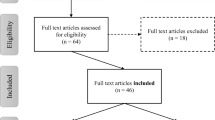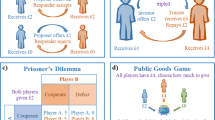Abstract
In game theory, the word ‘game’ is used to describe any interdependence between interacting parties, and the Nash equilibrium is a prominent tool for analysing such interactions. I argue that the concept of the Nash equilibrium may also be used in non-gaming contexts. An individual is in a Nash equilibrium if his or her beliefs are consistent with his or her actions. Given that discordance between beliefs and behaviour is a typical cause of psychiatric disorders, individuals who are not in a Nash equilibrium are likely to be affected by such disorders. In this regard, the concept of the Nash equilibrium could aptly be introduced into the medical practitioner’s vocabulary for describing a patient’s mental health status.
Similar content being viewed by others
Notes
Henceforth, intervals of the form (a,b) indicate all real numbers from a to b, but excluding a and b, whereas intervals of the form [a,b] indicate all real numbers from a to b, including a and b.
References
Nash, John. 1950. Equilibrium points in n-person games. Proceedings of the National Academy of Science of the USA 36: 48–49.
Nash, John. 1951. Non-cooperative games. Annals of Mathematics 54: 286–295.
Myerson, Roger B. 1999. Nash equilibrium and the history of economic theory. Journal of Economic Literature 37: 1067–1082.
Aumann, Robert J., and Sergiu Hart, eds. 1992. Handbook of Game Theory with economic applications. Amsterdam: North-Holland.
Sonnenberg, Amnon. 2000. Special review: Game theory to analyse management options in gastro-oesophageal reflux disease. Alimentary Pharmacology & Therapeutics 14: 1411–1417.
Marco, Alan P. 2001. Game theory in the operating room environment. The American Surgeon 67: 92–96.
Frank, Theodore H., and Marie Gryphon. 2009. Negotiating in the shadow of ‘bad faith’ refusal to settle: A game theory model of medical malpractice pre-trial settlements and insurance limits. SSRN electronic library. http://ssrn.com/abstract=1463655. Accessed 6 Dec 2010.
Geanakoplos, John, David Pearce, and Ennio Stacchetti. 1989. Psychological games and sequential rationality. Games and Economic Behavior 1: 60–79.
Deaves, Richard, Erik Lueders, and Guo Ying Luo. 2003. An experimental test of the impact of overconfidence and gender on trading activity. SSRN electronic library. http://ssrn.com/abstract=497284. Accessed 6 Dec 2010.
Johnson, Dominic D.P., Rose McDermott, Emily S. Barrett, et al. 2006. Overconfidence in wargames: Experimental evidence on expectations, aggression, gender and testosterone. Proceedings of the Royal Society B: Biological Sciences 273: 2513–2520.
Krane, Vikki, and Jean M. Williams. 1994. Cognitive anxiety, somatic anxiety, and confidence in track and field athletes: The impact of gender, competitive level and task characteristics. International Journal of Sport Psychology 25: 203–217.
Steedman, Ian, and Ulrich Krause. 1986. Goethe’s Faust, Arrow’s possibility theorem and the individual decision-taker. In The multiple self, ed. Jon Elster, 197–231. Cambridge: Cambridge University Press.
Smith, Adam. 1976 [1759]. The theory of moral sentiments. In ed. Daniel Raphael and Alec Macfie. Oxford: Oxford University Press.
Sugden, Robert. 1991. Rational choice: A survey of contributions from economics and philosophy. Economic Journal 101: 751–785.
Varoufakis, Yanis. 1998. Foundations of economics. London: Routledge.
Cowen, Leon. 1972. Anxiety, self-concept and the semantic differential. Journal of Psychology 80: 65–68.
Kleitman, Sabina, and Lazar Stankov. 2001. Ecological and person-oriented aspects of metacognitive processes in test-taking. Applied Cognitive Psychology 15: 321–341.
Kruger, Justin, and David Dunning. 1999. Unskilled and unaware of it: How difficulties in recognizing one’s own incompetence lead to inflated self-assessments. Journal of Personality and Social Psychology 77: 1121–1134.
Robson, Philip J. 1988. Self-esteem—a psychiatric view. British Journal of Psychiatry 153: 6–15.
Silverstone, Peter H., and Mahnaz Salsali. 2003. Low self-esteem and psychiatric patients: Part I—the relationship between low self-esteem and psychiatric diagnosis. Annals of General Hospital Psychiatry 2(1): 2.
Abela, John R.Z., and Benjamin L. Hankin. 2008. Cognitive vulnerability to depression in children and adolescents: A developmental psychopathology perspective. In Handbook of depression in children and adolescents, ed. John R.Z. Abela and Benjamin L. Hankin, 35–78. New York: The Guilford Press.
Reinecke, Mark A., and Anne Simons. 2005. Vulnerability to depression among adolescents: Implications for cognitive-behavioral treatment. Cognitive and Behavioral Practice 12: 166–176.
Capps, Donald. 2010. Understanding psychosis: Issues and challenges for sufferers, families and friends. United Kingdom: Rowman & Littlefield Publishers.
Jung, Carl G. 1966. The relations between the ego and the unconscious. In Two essays in analytical psychology, vol. 7 of Collected works of C.G. Jung, ed. Gerhard Adler and Richard F.C. Hull, 127–241. Princeton: Princeton University Press.
Krabbendam, Lydia, Ilse Janssen, Maarten Bak, Rob V. Bijl, Ron de Graaf, and Jim van Os. 2002. Neuroticism and low self-esteem as risk factors for psychosis. Social Psychiatry and Psychiatric Epidemiology 37: 1–6.
Brown, George W., Bernice Andrews, Antonia Bifulco, and Hans O.F. Veiel. 1990. Self-esteem and depression: I. Measurement issues and prediction of onset. Social Psychiatry and Psychiatric Epidemiology 25: 200–209.
Shedler, Jonathan. 2010. The efficacy of psychodynamic psychotherapy. American Psychologist 65: 98–109.
Hankin, Benjamin L., and Lyn Y. Abramson. 2002. Measuring cognitive vulnerability to depression in adolescence: Reliability, validity and gender differences. Journal of Clinical Child and Adolescent Psychology 31: 491–504.
Stuart, Scott, and Michael Robertson. 2003. Interpersonal psychotherapy: A clinician’s guide. New York: Oxford University Press.
Bem, Daryl J. 1972. Self-perception theory. In Advances in experimental social psychology, vol. 6, ed. Leonard Berkowitz, 1–62. New York: Academic Press.
Elster, Jon, ed. 1986. The multiple self. Cambridge: Cambridge University Press.
Author information
Authors and Affiliations
Corresponding author
Rights and permissions
About this article
Cite this article
Patokos, T. The relevance of Nash equilibrium to psychiatric disorders. Theor Med Bioeth 32, 245–258 (2011). https://doi.org/10.1007/s11017-011-9175-z
Published:
Issue Date:
DOI: https://doi.org/10.1007/s11017-011-9175-z




